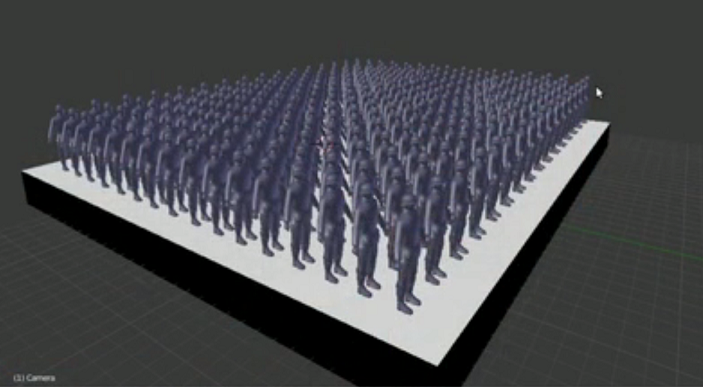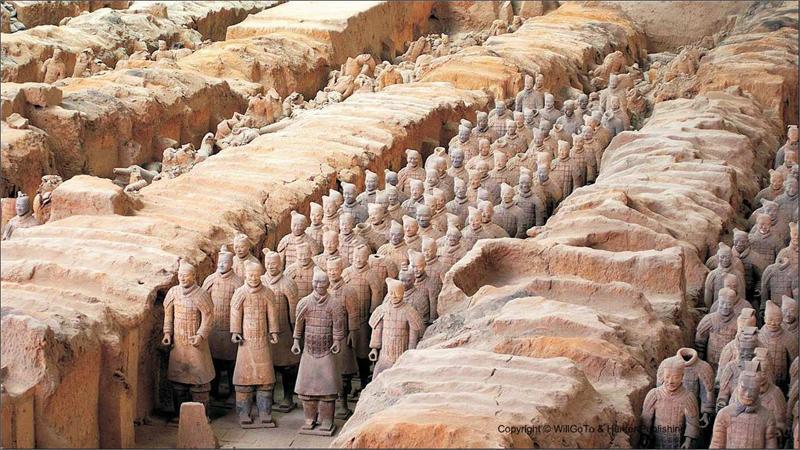 3D printing meets political consciousness-raising in a sculpture project by Cambridge University graduate student, Leo Impett. The tech-savvy Impett, who moonlights as “a computer-vision researcher for Microsoft,” is engaging the public in his project, The Digital Terracotta Army, to emphasize the necessity of empathy in the context of ongoing military conflicts across the globe.
3D printing meets political consciousness-raising in a sculpture project by Cambridge University graduate student, Leo Impett. The tech-savvy Impett, who moonlights as “a computer-vision researcher for Microsoft,” is engaging the public in his project, The Digital Terracotta Army, to emphasize the necessity of empathy in the context of ongoing military conflicts across the globe.
The project derives its name from the well-known Terracotta Warriors representing the army (and horses as well as other figures such as musicians, acrobats, and strongmen) of Qin Shi Huang, the first Emperor of China. Considered funerary art, the figures, which date to the late third century BCE, have been systematically excavated in the Emperor’s necropolis after their discovery by a farmer in 1974. They are staggering in numbers alone, with upwards of 8,000 soldiers, 520 horses associated with 130 chariots, and the other figures mentioned above.
Impett’s Digital Terracotta Army, while comparably vast, will be much smaller in scale. Whereas the original Terracotta Army included figures with distinctive facial features, it has been concluded that there were only eight variations–clay masks applied to heads and molded with additional clay to create individuality.
The Cambridge grad student-sculptor has conceived of a more extensive process for individualizing his figures: He has appealed to the public, via a Kickstarter project, to submit webcam photos of themselves, using an “html web app” that he provides. He explains, “We make your 2D photo into a 3D model of your face, using sophisticated computer graphics. We use this model to ‘graft’ your face onto the 3D model of a toy soldier.”
The “toy soldiers” populate Impett’s Digital Terracotta Army, a misnomer to the extent that his figures will not actually be produced using terracotta. The individual soldiers or “warriors” that comprise the ranks of these miniscule armies, not solely real-life military personnel, but they are also representative of the so-called “casualties” of contemporary military conflicts around the world. With one such grouping, says Impett, “we tell the story of the Israel-Palestine conflict, in 2014 only, in terms of the number of deaths. Here, each toy soldier represents not one, but ten deaths. There are 102 soldiers in black, for one-tenth of the military deaths. 164 soldiers are in red, these are a tenth of adult civilians.” To further emphasize the costs of war to civilian populations, the sculptor notes, “58 of them are in white–these are one-tenth of the children who’ve died so far in the conflict this year.”
After being 3D printed, the figures are arranged in a grid on a base, something like pieces on a chess board, but each has individual features. “Imagine the scene,” continues Impett, “more than three hundred toy soldiers, children’s toys–ten deaths for each one.” By making each figure unique, their creator hopes to heighten the emotional impact of the different sets. The grid-oriented arrangement of the figures echoes graphs that supply emotionless statistics, numbers rather than actual, individual human lives.
It is Impett’s hope that, when viewers of his work examine the individual figures and register their unique appearances, a sense of empathy is engendered. “Every soldier must have an identity, a background, a childhood, a love-story, a tragedy–without it,” he says, “the work is just a statistic.” The Cambridge graduate student worked on a project involving teaching empathy to autistic children. The children were shown images of people expressing emotion in response to various stimuli, but the children’s features–and related expressions–were superimposed on the faces of others. This project inspired Impett’s Digital Terracotta Army sculptural project. He believes that a dearth of empathy in this age of increasingly high-tech military conflict makes it possible for people to distance themselves emotionally from the real implications–and very human costs–of war.
As is the case with many artists, Impett must appeal for outside funding for his project. Rather than simply requesting donations, he asks donors to be a part of the project in a very directly physical way. In order to produce refined, detailed likenesses of the individual soldiers, the artist explains that he needs to upgrade his 3D printer to a “much higher-resolution Makerbot.” His Kickstarter fundraising campaign runs through October 28. Check out the Kickstarter Pitch Video below. Discuss Impett’s project in the 3D printed Terracotta Army forum thread on 3DPB.com.
Subscribe to Our Email Newsletter
Stay up-to-date on all the latest news from the 3D printing industry and receive information and offers from third party vendors.
You May Also Like
Nano Dimension Expands Micro-Manufacturing with Exa 250vx 3D Printer
As it continues to push for the acquisitions of Desktop Metal and Markforged, Nano Dimension has introduced a new micro-3D printing system at Formnext. Adding to the Fabrica Tera and...
3D Systems Pushes New Tech and Partnerships at Formnext
As one of the pioneering companies in additive manufacturing (AM), 3D Systems remains a key player to watch at Formnext 2024, where it is showcasing major partnerships, innovative technologies, and...
Formnext 2024 Roundup: Pellet 3D Printing, Advanced Software, & More
Europe’s leading additive manufacturing trade show, Formenxt 2024, comes to a close today. There have been many product, material, software, and other business announcements during the event, and we’ll summarize...
Formnext 2024: Worldwide Release of Meltio Engine Blue Robotic Arm Integration Kit
Formnext 2024 is currently taking place in Frankfurt, and as you would imagine, the announcements of new machines, materials, software, and more have been flying fast and furiously into our inboxes....





































